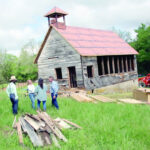In addition to having a house in the city, my wife and I have recently purchased some acreage southeast of Cassville that is cleared and produces a lot of hay when we want to put up hay bales, or we can lease it out to someone who is raising cattle.
In order to keep the high quality and production of the grazing land, it is now time to fertilize again, and we have found that the price of fertilization is double or triple what it used to be. So, we understand farmers wanting to get fertilizer at the lowest cost possible to themselves, but as one of our local large landowners stated ‘at what cost to us’ and, obviously, what cost to our future generations.
My wife and I will never use poultry processing effluent as a fertilizer on our farm, because we care too much about maintaining clean, clear drinking water for us and our grandchildren. Additionally, because we think that eventually that adding non-tested, non-controlled substances to the surface of the land will eventually pollute our groundwater and streams, especially Roaring River and Flat Creek.
As the County Health Department has stated, nitrates in excess of 10 parts per million can make a private water well be deemed to be unsafe. And after some research it looks like effluent from sewage treatment plants must not have nitrates over 200 parts per million.
As the article in the paper indicated, the nitrogen in the sample taken was found to be 86.53 pounds per 1000 gallon. 86.53 lbs. per 1000 gal. (8340 lbs.) is equal to 1037 parts per million. This is more than four times as high as the safe level for dumping it into our streams. I realize that material placed on ground is not the same as placing it directly in streams, but if they are placing hundreds of thousands of gallons of this processed, untreated, untested, unregulated effluent water on the lands of Barry County every week, then I feel with great certainty that someday our waters, both surface and groundwater, will be unsafe to swim in, fish in or especially to drink.
The George Orwellian “double-speak” that we now seem to be getting from our state agencies is very concerning. The DNR state that they cannot test the stuff because it is supposedly a fertilizer, yet the lagoons from which they are obtaining the effluent apparently do not meet the definition of a “agrochemical facility.” What is going on? It looks like someone is not willing to do their job, or somebody has told someone to keep hands off. In all of the above, I have not mentioned the most obvious negative factor about placing this effluent on Barry County land, and that is the odor. Either way, the citizens of Barry County are getting the “stinky” end of the stick, so to speak.
At one of my previous places of employment, I was City Engineer in one of the suburbs of Tulsa, Okla. At that time, we had a sewage treatment plant at which we placed our sludge in drying beds.
After it was dried out, we allowed farmers to come and pick it up and place it on their land. In the early 1980s, Oklahoma Department of Health passed a law that stated that cities could no longer allow farmers to take their sludge and place on their land because the sludge had a potential for a high concentration of nitrogen and there was a potential of carcinogens being in this sludge.
This was 40 years ago. I can’t believe we’re still allowing effluent from animal processing facilities to be placed on our farm land, to potentially be washed down into our streams and to be absorbed into our drinking water aquifers.
My wife and I think that it would be doing a great disservice to our grandchildren, our great, great grandchildren and all future generations if we don’t do everything we can to make sure that what we are placing on the land and what is absorbed into the land does not contaminate our surface waters and our drinking water.
There was a reason that Granddad said, “you never dig your water well downhill from your septic tank.”
H. Lynn Hilburn
Cassville







Thank You for your comments.